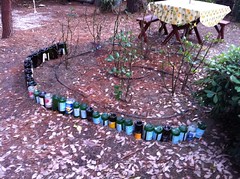As part of my work with Troy-Bilt, I regularly write for their monthly newsletter, The Dirt. This month, my article is entitled “Inch-by-Inch” and appears below in it’s entirety.
If you would like to subscribe to The Dirt, visit the Troy-Bilt web site and subscribe.
Your garden – inch by inch by Douglas Welch, A Gardener’s Notebook
Often we look at our garden plant by plant – which is doing well, which is doing poorly, which one needs to be moved. At other times, we try to take in the big picture. We map, we plan and try to create one seamless whole. There are times, though, when inch-by-inch is the way we see it, and it brings a unique viewpoint.
The Edging
Several weeks ago we started a new edging project in the garden. Beginning with the smallest rose bed, we decided to use old wine and glass water bottles to surround the bed. The previous limbs we had used were now several years old and had deteriorated almost completely. I did a bit of research online, including looking for images of bottle edging, to make sure we wanted to proceed. It certainly seemed worth a try. We would do this small bed first and then decided if we wanted to continue it in others.
Of course, doing an edging project like this means getting “down and dirty” with your garden – usually on your hands and needs. You notice immediately how the soil differs inside the bed to the hard, compacted soil of the surrounding paths. You get a clear view of the quality of the soil in the beds as you dig the trench alongside.
You notice insects – good and bad – weeds, and maybe even the rust that is forming on the lower leaves of the roses that you hadn’t noticed before. Oh, oh, are those aphids?!? Ah, but you also notice the lady larvae and adults ready to eat them up. Your garden takes on a different meaning on this micro scale. You don’t notice the thistles and bindweed as much, but the blackspot and Japanese beetles really catch your eye. You don’t notice the bad pruning on the box hedges, but the quality of the soil as it sits in your hand makes you sit in wonder for just a moment.
A project
If all this sounds very foreign to you, I am going to charge you with a project the next time you are in your garden. Take a 1-meter-square area of your garden and mark it off in some way. Use a piece of rope or string to outline the area. If you have seen archaeologists working in movies or on TV, think about what their digs look like. While this 1 meter can be a patch of lawn, consider placing it over the junction between a bed and the lawn. You’ll get better results in your experiment.
Now that you have marked out the area, sit down – better yet, lie down on your belly – and start to take note of every living thing you see there. First off you’ll see the grass, the daylilies, the small weeds. Then look deeper. You’ll see ants, aphids, beetles and a host of other insects. Keep looking. Now there are worms, spiders, sow bugs, spider mites and more. I can guarantee you that you will notice more than you ever thought possible in your small 1 meter area and all of it is there, teeming with life, every day.
I know that, for me, observing my garden in this macroscopic way brings a deeper appreciation and deeper understanding of my garden when I look out from my back door each morning, coffee cup in hand. I never see just the paths and the plants anymore. In my mind I see it all – everything that exists down there among the roots, as well as everything on the surface.
It is quite amazing how a small garden project can lead you down the merry path of deep thoughts, but, then again, isn’t that one major reason we garden in the first place?
This post is part of my paid work as part of Troy-Bilt’s Saturday6. The opinions are solely mine.

